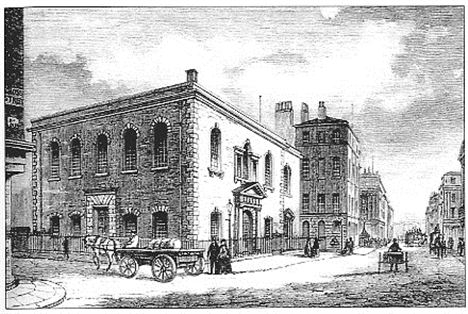A LONG-TERM archaeological project got under way in the Cross Street area of Manchester city centre this week, as part of Metrolink’s Second City Crossing (2CC).
As part of the process, a public notice was issued listing names of the dead and inviting any potential ancestors to come forward but, to date, none have.
Ground investigations carried out along the alignment of the tram route on Cross Street found the remains of over 100 people, interred 150 to 200 years ago and affiliated to the Unitarian Church.
 Eighteenth-century Cross Street Chapel and a dead person on a cart, perhaps
Eighteenth-century Cross Street Chapel and a dead person on a cart, perhaps
As they are within the footprint of the tramway, they need to be moved, sensitively and respectfully, and reinterred in order for the new Metrolink line to be installed.
In doing so, the Greater Manchester Archaeological Advisory Service (GMAAS) at the University of Salford will be monitoring the fieldwork of CFA Archaeology Ltd, recording any discoveries of note from the site and producing a formal report. The report of their findings will be placed on record at Manchester Central Library at the end of the project.
Transport for Greater Manchester (TfGM) has been liaising closely with GMAAS, Manchester City Council, the church authorities and the Ministry of Justice in securing all the necessary approvals and permissions for this work.
As part of the process, a public notice was issued listing names of the dead and inviting any potential ancestors to come forward but, to date, none have.
The project is expected to take several months to complete.
Peter Cushing, TfGM’s Metrolink Director, said: “We fully recognise the duty of care involved – that is why we are following all statutory procedures and are working closely with church and archaeological officials to ensure this work is completed sensitively and respectfully.
“We will, of course, ensure that any work sites involved are secure and enclosed, out of respect for both the nature of the work and any residents or businesses in the immediate vicinity. All appropriate precautions will be followed.
“We are working very closely with church officials to ensure re-interments are carried out respectfully, and we hope that the history being uncovered will be of interest to the archaeological society.”
Senior Planning Archaeologist at GMAAS, Dr Andrew Myers, said: “Historically, the growth of industrial Manchester in the late eighteenth and nineteenth centuries is a story of global significance.
“The archaeological investigation and recording of the Cross Street Chapel burials provides a rare opportunity.
“We can learn directly from the remains of individuals who were part of the non-conformist movement in Manchester, which played a key role promoting awareness of the conditions in which working populations were living and in campaigns for social reforms.”
More information about the Second City Crossing (2CC) can be found at www.transformationinformation.co.uk, or by contacting the Future Metrolink team on 0161 244 1555 (during office hours) or emailing future.metrolink@tfgm.com.











